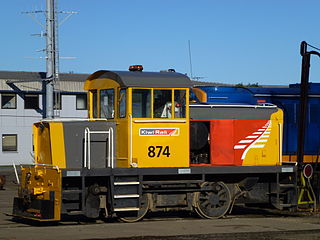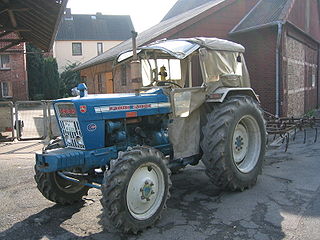
The Unimog is a range of multi-purpose tractors, trucks and lorries that has been produced by Boehringer from 1948 until 1951, and by Daimler Truck since 1951. In the United States and Canada, the Unimog was sold as the Freightliner Unimog.

A tractor is an engineering vehicle specifically designed to deliver a high tractive effort at slow speeds, for the purposes of hauling a trailer or machinery such as that used in agriculture, mining or construction. Most commonly, the term is used to describe a farm vehicle that provides the power and traction to mechanize agricultural tasks, especially tillage, and since many more. Agricultural implements may be towed behind or mounted on the tractor, and the tractor may also provide a source of power if the implement is mechanised.

The Caterpillar D9 is a large track-type tractor designed and manufactured by Caterpillar Inc. It is usually sold as a bulldozer equipped with a detachable large blade and a rear ripper attachment.

A traction engine is a steam-powered tractor used to move heavy loads on roads, plough ground or to provide power at a chosen location. The name derives from the Latin tractus, meaning 'drawn', since the prime function of any traction engine is to draw a load behind it. They are sometimes called road locomotives to distinguish them from railway locomotives – that is, steam engines that run on rails.

Fordson was a brand name of tractors and trucks. It was used on a range of mass-produced general-purpose tractors manufactured by Henry Ford & Son Inc from 1917 to 1920, by Ford Motor Company (U.S.) and Ford Motor Company Ltd (U.K.) from 1920 to 1928, and by Ford Motor Company Ltd (U.K.) from 1929 to 1964. The latter also later built trucks and vans under the Fordson brand.

A cultivator is a piece of agricultural equipment used for secondary tillage. One sense of the name refers to frames with teeth that pierce the soil as they are dragged through it linearly. Another sense refers to machines that use rotary motion of disks or teeth to accomplish a similar result. The rotary tiller is a principal example.
Scammell Lorries Limited was a British manufacturer of trucks, particularly specialist and military off-highway vehicles, between 1921 and 1988.

The Loyd Carrier was one of a number of small tracked vehicles used by the British and Commonwealth forces in the Second World War to transport equipment and men about the battlefield. Alongside the Bren, Scout and Machine Gun Carriers, they also moved infantry support weapons.
Muir Hill (Engineers) Ltd was a general engineering company based at Old Trafford, Manchester, England. It was established in the early 1920s and was significant in the production of simple rail locomotives, and later high horse power tractors and post Second World War dumpers.

The New Zealand TR class locomotive is a type of diesel shunting locomotives built by many different manufacturers. Defined as "shunting tractors" or "rail tractors" by KiwiRail and its predecessors, they are classified "TR" for tractor as a result. Many of these locomotives have been withdrawn, but some are still in service. The first locomotive of this class was built by NZR in 1924. The most powerful were Japanese-built Hitachi TRs, with 138 kW Cummins engines.

The Ford 5000 is a blue and white tractor that was produced from 1964 to 1979 by Ford. It was a mid-range tractor, suitable for European farms. The North American versions was slightly different and was named the Ford Major. A similar model, the Ford 3000 was introduced in the spring of 1965.

The Lycoming O-145 is a family of small, low-horsepower, four-cylinder, air-cooled engines. It was Lycoming Engines' first horizontally opposed aircraft engine and was produced from 1938 until the late 1940s. The family includes the reduction-geared GO-145. The O-145 received its Approved Type Certificate on 13 Jun 1938.
The Cuyuna 430 and Cuyuna 340 are a family of two-stroke, twin-cylinder piston snowmobile engines that were redesigned to serve as ultralight aircraft powerplants.

The Hirth 2702 and 2703 are a family of in-line twin cylinder, two stroke, carburetted aircraft engines designed for use on ultralight aircraft and especially two seat ultralight trainers, single seat gyrocopters, and small homebuilts. It is manufactured by Hirth of Germany.
The Hirth 2704 and 2706 are a family of in-line twin cylinder, two stroke, carburetted aircraft engines, with optional fuel injection, designed for use on ultralight aircraft and especially two seat ultralight trainers, single seat gyrocopters and small homebuilts. It was manufactured by Hirth of Germany.
The Hirth 3202 and 3203 are a family of in-line twin cylinder, two stroke, carburetted aircraft engines, with optional fuel injection, designed for use on ultralight aircraft, especially two seat ultralight trainers, gyrocopters and small homebuilts. It is manufactured by Hirth of Germany.
The Hirth 3502 and 3503 are a family of liquid-cooled, in-line twin-cylinder, two-stroke, carbureted aircraft engines, with optional fuel injection, designed for use on ultralight aircraft and small homebuilts. It is manufactured by Hirth of Germany.
The Zanzottera MZ 201 and MZ 202 are a family of twin-cylinder, in-line two-stroke, dual ignition aircraft engines designed for ultralight aircraft and motor gliders.
Lindner Traktorenwerk GmbH is an Austrian agricultural machinery manufacturer. Lindner is a family company based in Kundl, Austria that has produced tractors and transporters for mountain and grassland management and for forestry and municipal applications since 1948. The company was the first manufacturer of a four-wheel drive tractor in Austria.

The Schlüter Profi Trac 5000 TVL is an agricultural tractor made by Anton Schlüter München. It is their biggest, and most powerful tractor.













